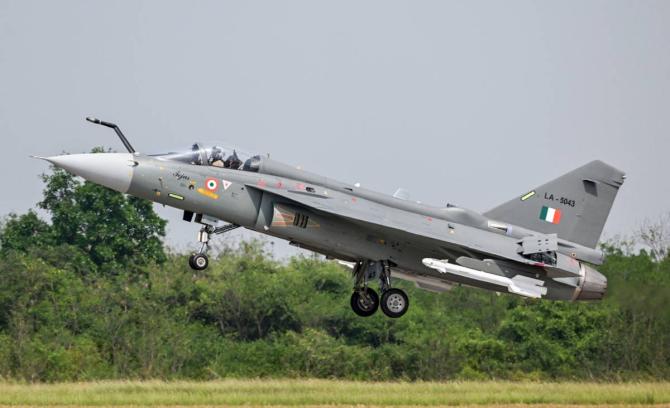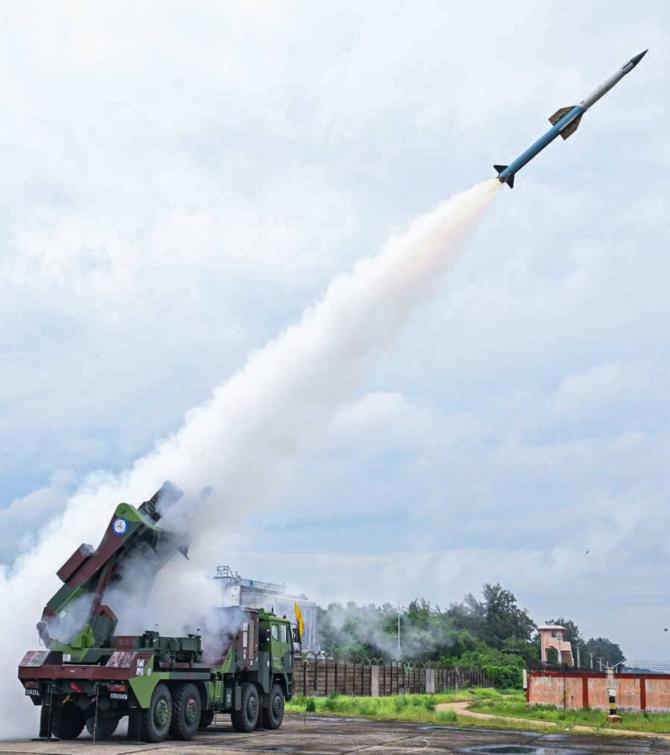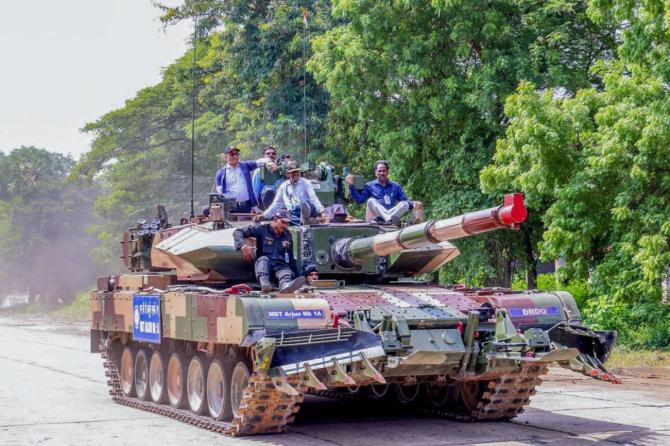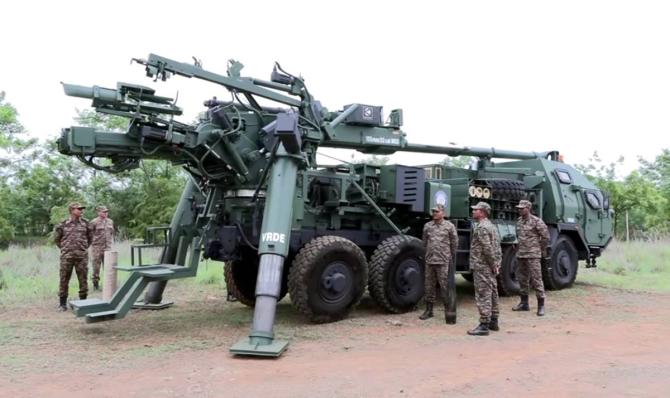The first part of my interview with Prof M Vidyasagar, FRS has appeared today in Rediff and the second part will appear soon.
( https://www.rediff.com/news/interview/india-builds-best-when-it-builds-alone/20251029.htm )Why The Americans Were Opposed To Agni
'The heat shield technology for re-entry vehicles was first mastered in DRDO for the Agni missile.'
'This is why the Americans were so opposed to Agni in the 1980s, unlike other missiles -- it was a re-entry vehicle.'

Professor M Vidyasagar, FRS, is a Distinguished Professor at IIT Hyderabad. He earned his BS, MS, and PhD in electrical engineering from the University of Wisconsin.
His distinguished career includes academic positions at universities in the USA and Canada, followed by leadership roles as Director of India's Centre for AI and Robotics and Executive VP at Tata Consultancy Services.
He held a chaired professorship at the University of Texas in Dallas before his current position.

A major feather in the cap of his team at the Centre for AI and Robotics is the creation of world class digital control software for the Light Combat Aircraft Tejas indigenously.
His research interests span stochastic algorithms, convex/nonconvex optimization, reinforcement learning, and machine learning, with recent work focusing on the theoretical foundations of stochastic gradient descent and Large Language Models.
Professor Vidyasagar, a prolific author of 13 books and over 160 peer-reviewed research papers, was appointed a Fellow of IEEE (the largest professional engineering body in the globe) for his advanced contributions to Control Systems at a very young age.
His groundbreaking contributions have been recognized with numerous prestigious honours, including Fellowship of The Royal Society (FRS), the IEEE Control Systems Award, the Rufus Oldenburger Medal (ASME), and the John R Ragazzini Education Award (AACC).
He is also a Fellow of multiple national academies in India and a recipient of a SERB National Science Chair.
"I believe a significant handicap is that the critical need for our own technology to win wars has never been burned into the memory of our government and armed forces. But let's look at the positive achievements. The nuclear submarine, the aircraft carrier, the Tejas fighter, and the guided missiles programme -- including newer missiles and the excellent BrahMos joint venture -- are all visible, major system successes," Professor M Vidyasagar tells Shivanand Kanavi. The first of a two-part must-read interview.
A major feather in the cap of his team at the Centre for AI and Robotics is the creation of world class digital control software for the Light Combat Aircraft Tejas indigenously.
His research interests span stochastic algorithms, convex/nonconvex optimization, reinforcement learning, and machine learning, with recent work focusing on the theoretical foundations of stochastic gradient descent and Large Language Models.
Professor Vidyasagar, a prolific author of 13 books and over 160 peer-reviewed research papers, was appointed a Fellow of IEEE (the largest professional engineering body in the globe) for his advanced contributions to Control Systems at a very young age.
His groundbreaking contributions have been recognized with numerous prestigious honours, including Fellowship of The Royal Society (FRS), the IEEE Control Systems Award, the Rufus Oldenburger Medal (ASME), and the John R Ragazzini Education Award (AACC).
He is also a Fellow of multiple national academies in India and a recipient of a SERB National Science Chair.
"I believe a significant handicap is that the critical need for our own technology to win wars has never been burned into the memory of our government and armed forces. But let's look at the positive achievements. The nuclear submarine, the aircraft carrier, the Tejas fighter, and the guided missiles programme -- including newer missiles and the excellent BrahMos joint venture -- are all visible, major system successes," Professor M Vidyasagar tells Shivanand Kanavi. The first of a two-part must-read interview.

Thank you for your time, Professor Vidyasagar. There are many diverse things I want to talk to you about in which you have great expertise and experience. To begin with, what have been the major achievements of the Defence Research and Development Organisation (DRDO)?
DRDO has done extremely well in areas where it hasn't had to compete with the 'import option'.
Take missiles, for example. If you want a missile, you have to build it yourself; nobody will sell it to you.
This is also how ISRO succeeded -- you can't import a satellite launch vehicle.
In such segments, DRDO and ISRO come out looking very good. They have good scientists, but they also aren't constantly watching their backs against import lobbies.
Take for instance, the ring laser gyroscope developed by DRDO under the Integrated Guided Missile Programme.
Older missiles used mechanical gyroscopes; the new laser gyroscope is far more accurate.
Nobody would give that to us, so DRDO developed it indigenously.

However, in areas where an import option exists -- like fighter jets, main battle tanks, or towed artillery guns -- the moment DRDO gets close to a solution, someone shows up offering to sell it.
The sellers also have an interest in undermining DRDO.
What I've never understood is what's in it for the buyers, our government of the day and armed forces?
I believe a significant handicap is that the critical need for our own technology to win wars has never been burned into the memory of our government and armed forces.
But let's look at the positive achievements.
The nuclear submarine, the aircraft carrier, the Tejas fighter, and the guided missiles programme -- including newer missiles and the excellent BrahMos joint venture -- are all visible, major system successes.
There are also numerous critical subsystems developed that aren't as visible.
For example, the heat shield technology for re-entry vehicles was first mastered in DRDO for the Agni missile.
This is why the Americans were so opposed to Agni in the '80s, unlike other missiles -- it was a re-entry vehicle.
We also had to master the technology of mounting printed circuit boards in these missiles that can withstand extreme shock, vibration, and temperature.
The US had a far better ecosystem for spinning off military technology for civilian use --Teflon came from the space programme.
DRDO could have done this, but it was stifled by financial and ideological hurdles.
When Dr Kalam was director general of DRDO, we explored commercialising DRDO technology.
The problem was the finance ministry was terrified that an industry might buy a license and make a fortune.
Our attitude was DRDO has no mechanism for marketing, scaling up, or paying competitive salaries.
If we don't commercialise, the technology will die. Let someone take a chance and commercialise it.
But the officials were scared of audit objections from the CAG.
Their solution was to ask for a ridiculous amount of money upfront to avoid any future allegation of underpricing.

If we had adopted a model of taking a small royalty or an equity stake in the commercialising company, many small technologies could have proliferated into society.
Unfortunately, that model was unthinkable in the '90s. This resistance has prevented the diffusion of many technologies.
Fortunately, some groups with deep pockets like the Tatas can take chances.
For instance, some drones used abroad are actually made by a small, young entrepreneurial company in Hyderabad -- not a big corporate.
For example, armour-penetrating explosives could have had mining and other civilian applications. Similarly the laser gyro, heat shield etc.
The commercialisation never took off because our finance people were scared to make decisions.
I don't necessarily blame them; they fear audit objections. The whole system is messed up.
This is also why government startup funds often go unspent -- no one wants to take the risk inherent in venture capitalism, where you expect many failures for one big success.
This culture of audit objections stifles innovation, and no government, including the present one, has shown the willingness to truly understand and fix this problem.
You were the founder director of the Centre for Artificial Intelligence and Robotics (CAIR) at DRDO. Please tell me how that came about and what was achieved there.
It was an interesting time.
I was a professor at the University of Waterloo, Canada; at the top of my academic career, but my wife and I always wanted to return to India.
In 1987, I took a sabbatical and met Dr Kalam at DRDL (Defence Research and Development Laboratory) in Hyderabad.
I was struck by how hard everyone was working -- a testament to the impact of a charismatic leader.
I told him I was thinking of returning to India, and he said he'd look for an opportunity.
In September, just two months later, he told me that Dr V S Arunachalam, the scientific advisor to the defence minister, wanted to start a project on AI but couldn't find a leader.
He asked if I would lead it. I was interested but had to finish guiding my four PhD students in Waterloo.
I asked for a year's joining time, which was agreed upon.
When I joined DRDO, the 'CAIR Project' had a two-year lifetime in government terms.
My first task was to turn this project into a permanent establishment -- a laboratory.
This required navigating bureaucracy and defining what we would do.
I was met with tremendous goodwill, primarily because in 1989, the idea of a well-established academic returning to India was almost heretical. It rarely happened.
We defined our areas: In artificial intelligence, we started with rule-based expert systems and quickly moved to neural networks, which had just emerged in 1986.
In robotics, we coordinated with BARC's (Bhabha Atomic Research Centre) strong Division of Remote Handling and Robotics, led by the amazing Ram Kumar.
We decided that anything in a radioactive environment would be handled by BARC, and anything outside that would be our domain.
We were primarily an internal consultant for DRDO, not expected to build finished products but to be an in-house resource.
For example, we built a fault detection expert system for a radar being developed by LRDE.
We also developed a robotic system to uniformly coat the canopy of the Light Combat Aircraft with radar-absorbing material -- a critical stealth technology, as the canopy is the most reflective part of an aircraft.
We also did basic research. I probably had the highest percentage of PhDs in any DRDO lab.
By 1994, we had about 40 scientists and 80-85 people total, including support staff.
To get hiring flexibility, we set up a non-profit society called the Institute of Robotics and Intelligent Systems (IRIS), with the DRDO secretary as the ex-officio chairman.
This allowed us to hire on contract and pay somewhat higher salaries.
Our biggest success was the control law for the LCA.
It started around 1992. Girish Deodhare, who just retired as DG of ADA, was my PhD student at Waterloo and joined CAIR.
Dr Kota Harinarayana was the programme director of ADA.
Initially, Martin Marietta was supposed to design the control software. They would talk big but belittle Indian capabilities and refused to share design documents, only giving final numbers.
Dr Kalam, who took over as DG in July '92, called a meeting -- on a Sunday -- and appointed Professor Roddam Narasimha FRS, to head a committee to decide if we could build the control law indigenously. We all said we could.
These foreign companies weren't impressive technically and weren't offering a knowledge transfer.
We decided to go for a state-of-the-art digital fly-by-wire control with a 32-bit floating-point processor, which was advanced for the time.
Professor Narasimha recommended we do it ourselves, and Dr Kalam agreed. He appointed Professor I G Sharma of IISc as an independent assessor to report to the ADA governing council every three months.
We designed the first cut of the control law in about two years.
A major hurdle was computing power. Due to international restrictions, we couldn't get powerful computers in India.
We rented time on a British Aerospace flight simulator in the UK.
Our team would go there with the software on tapes, and our test pilots would fly the LCA control law on that simulator.
Interestingly, the BAE guys, who were also working on the Eurofighter, invited our pilots to try their simulator.
Our pilots later reported that they found the LCA's handling qualities to be better!
The control law's quality is best attested by the fact that the LCA is the first fighter aircraft in the world to be inducted into service without a single crash during its development phase.
Because it was completely in-house, and the test pilots who flew it eventually rose to senior decision-making positions in the air force, the system was well-accepted even though the import option always loomed.
The economics also flipped. In 1989, the assumption was that the LCA would be three times more expensive than a Mirage but would be ours.
Twenty years later, it was not only ours but also only 25%-30% of the cost of any imported equivalent fighter alternative.
There was an export market for an affordable, capable fighter, but we lacked the production capacity and the mindset to engage a private sector partner for mass production and marketing.
The ingrained mindset, fearing 'someone might make money', prevented this.
HAL's production rate was initially 6 per year, then 18 -- we need 50 to 60 per year to meet demand and export.
We see the same issue today with the Advanced Medium Combat Aircraft (AMCA).
The project was 'sanctioned' two years ago, but not a single rupee has been released.
Most people don't know that government sanction means expenditure power for when money is released, not that funds have been allotted.
Many times I doubt if our armed forces are serious about wanting indigenous equipment; they seem to delay until they can claim an urgent need to import.
Countries like the US field-test their equipment in local wars in the globe, creating testimonials for their technology.
In India, field trials are often used as an excuse to delay induction.
-----------------------------------------------------------------------------------------
Shivanand Kanavi, a frequent contributor to Rediff, is a theoretical physicist, business journalist and former VP at TCS.
He is the author of the award winning book Sand To Silicon: The Amazing Story Of Digital Technology and has edited Research By Design: Innovation and TCS; a chronicle of over 30 significant outcomes and case studies of TCS R&D from 1981-2006.
Feature Presentation: Ashish Narsale/Rediff
No comments:
Post a Comment